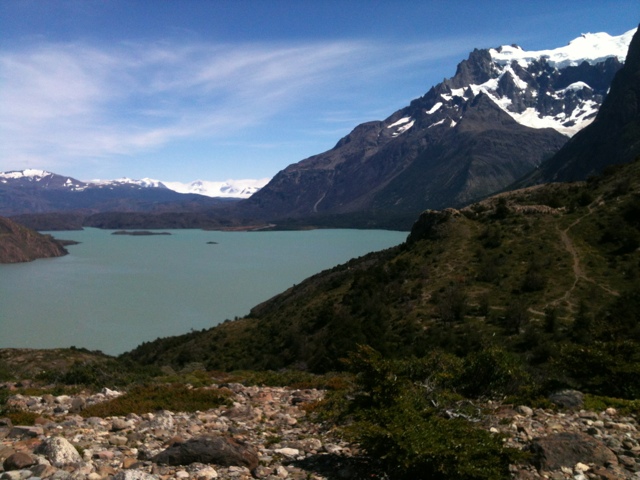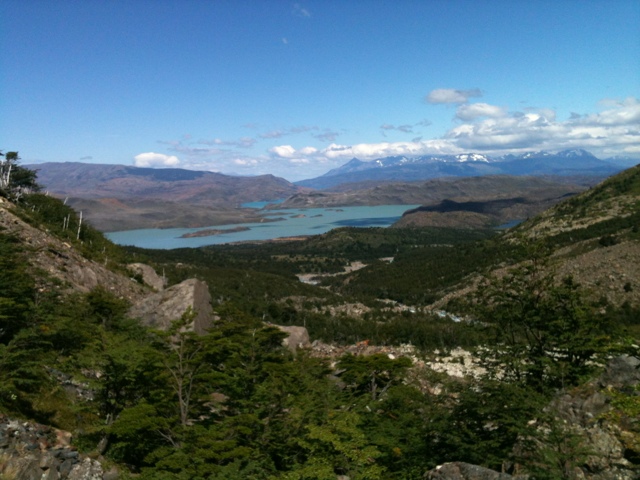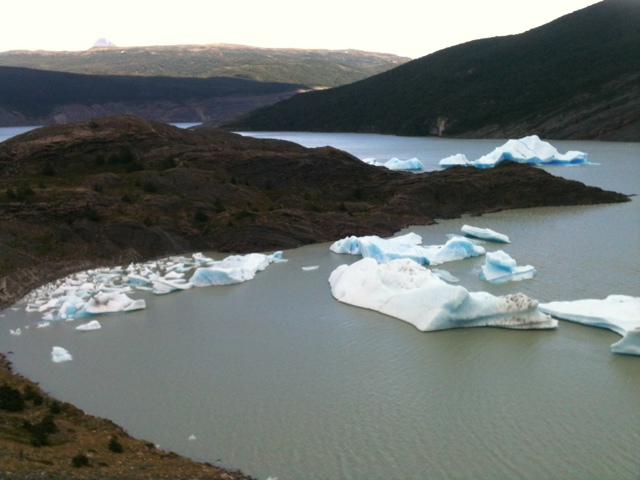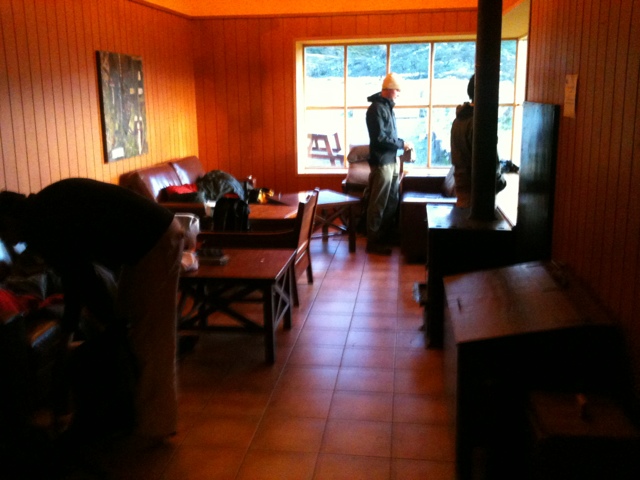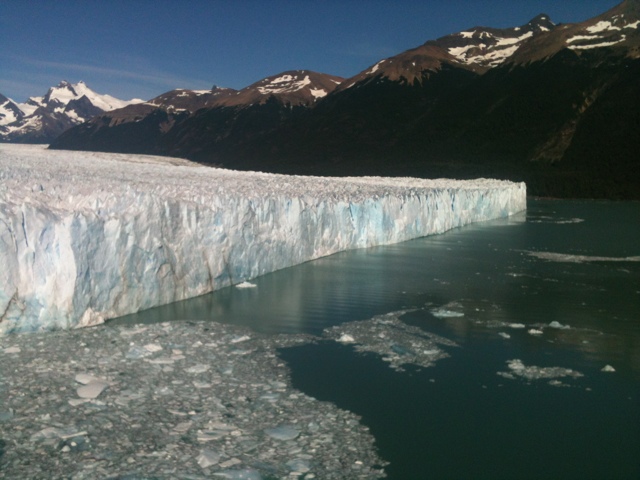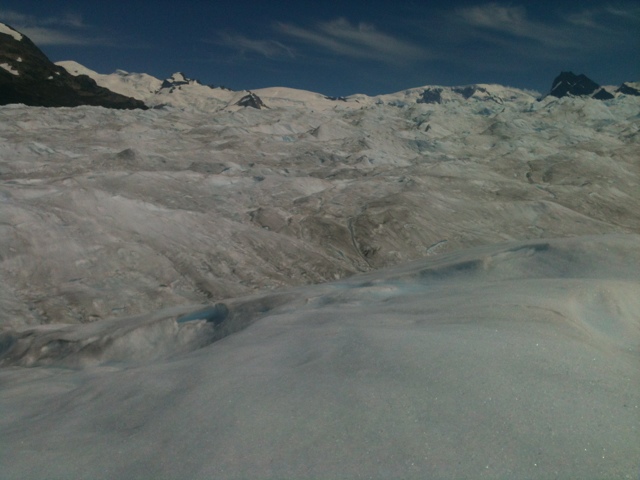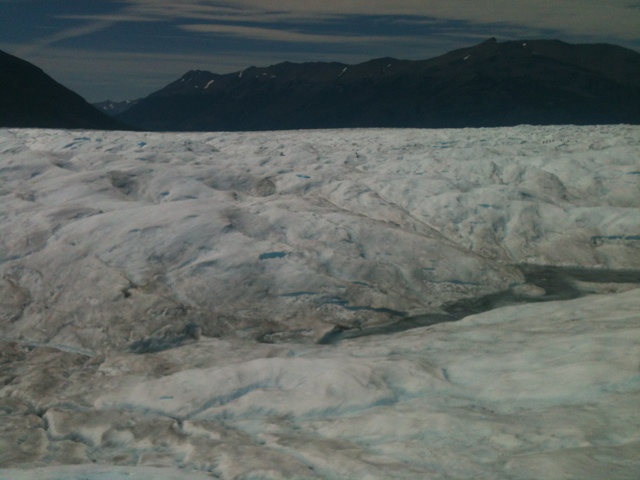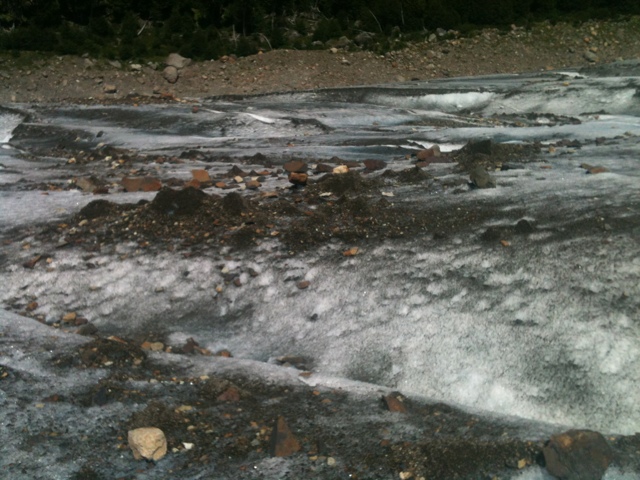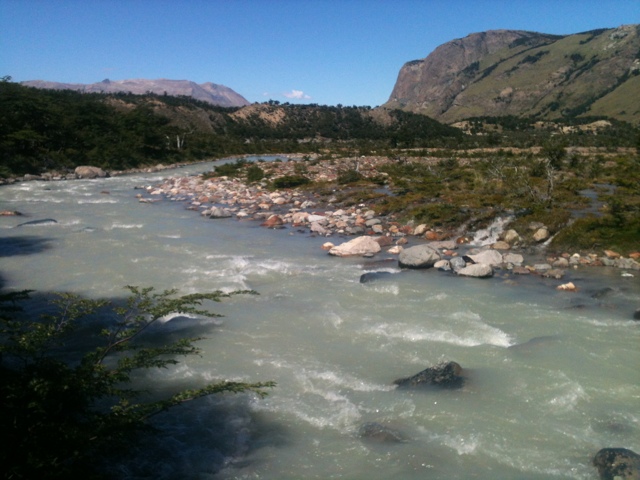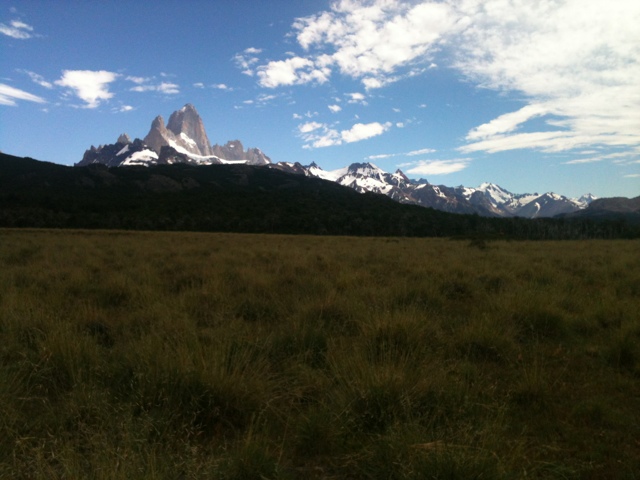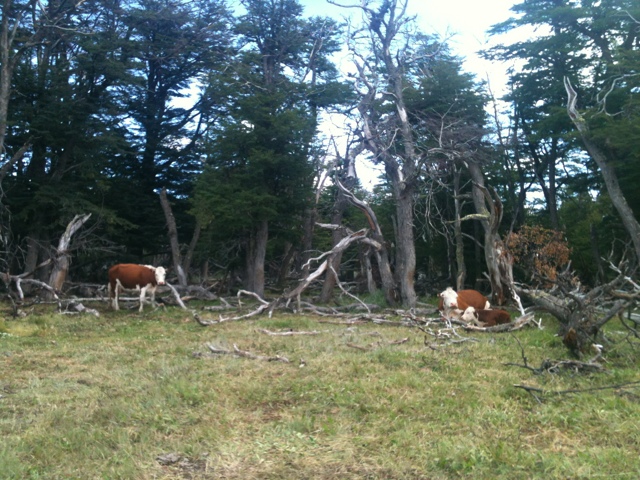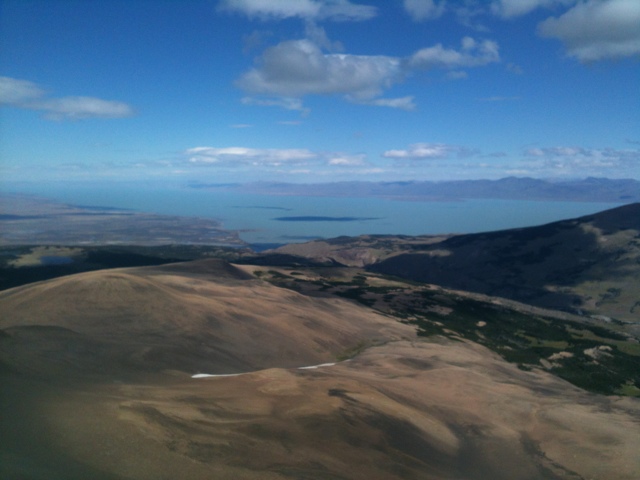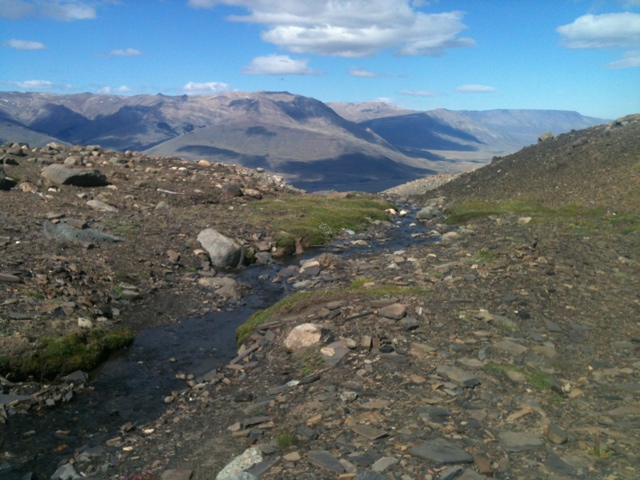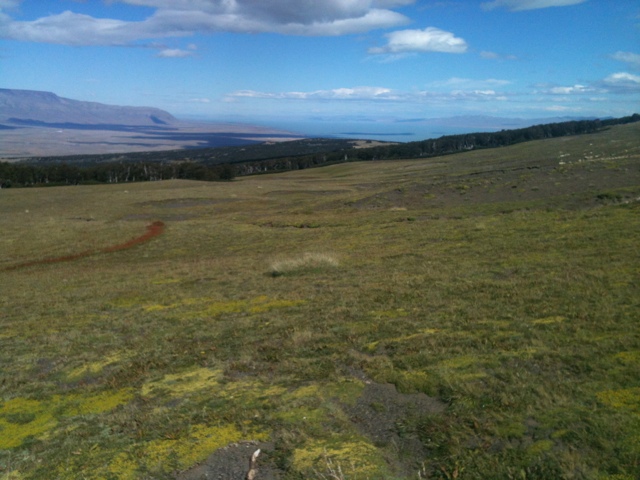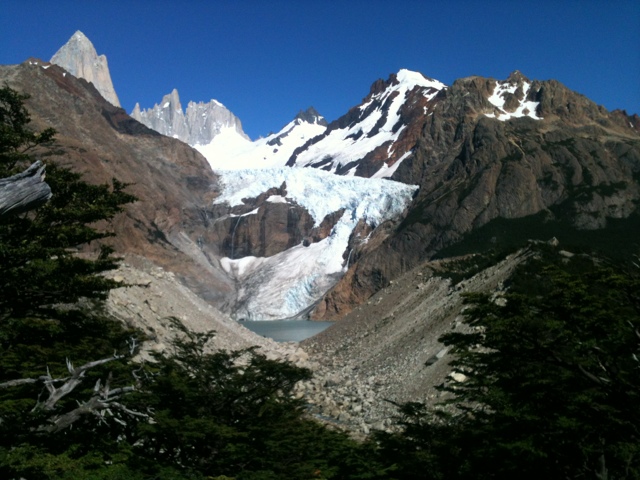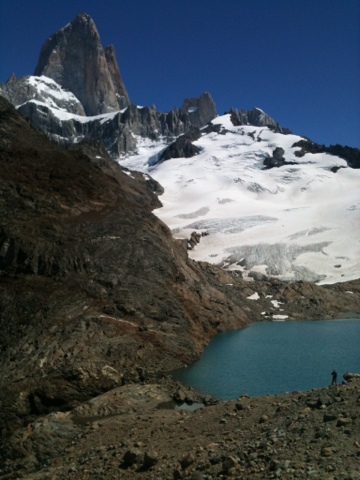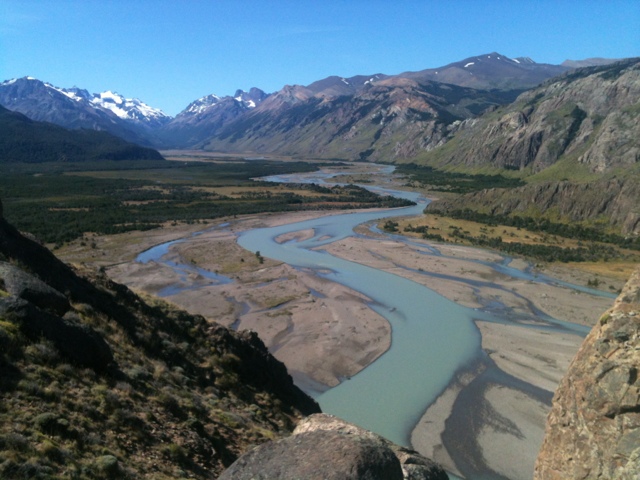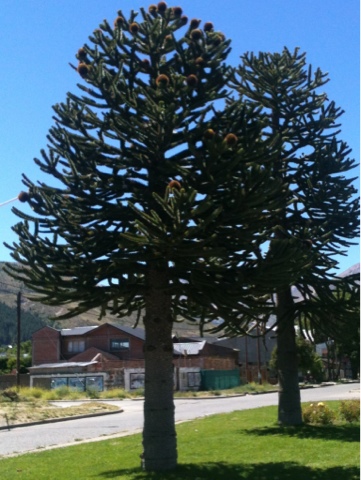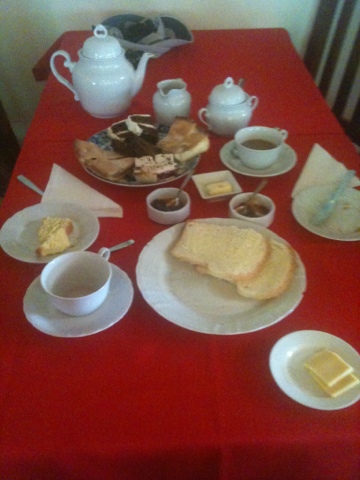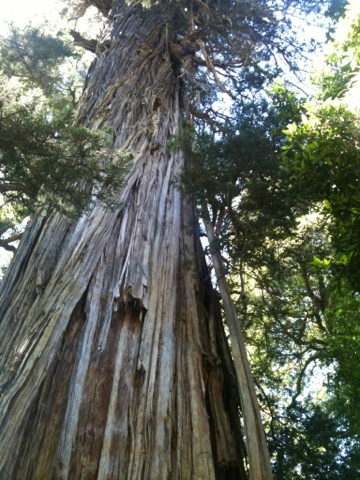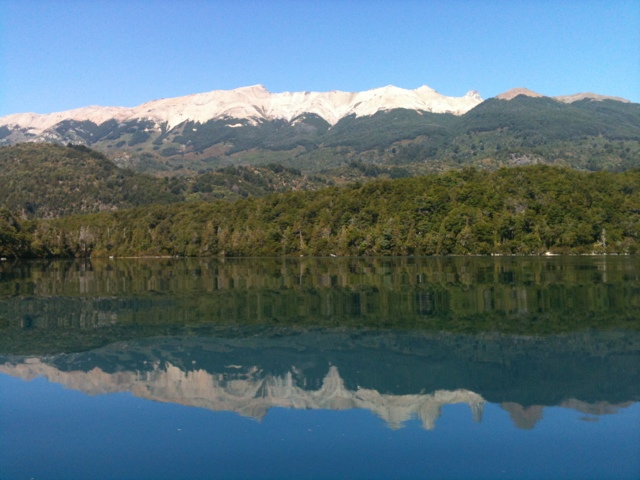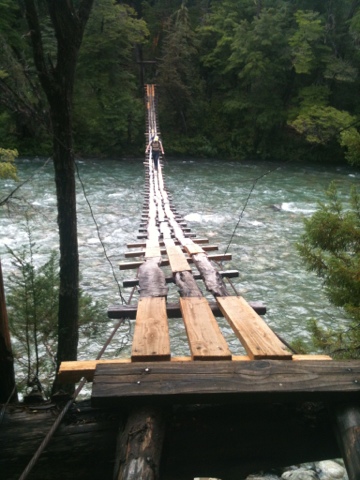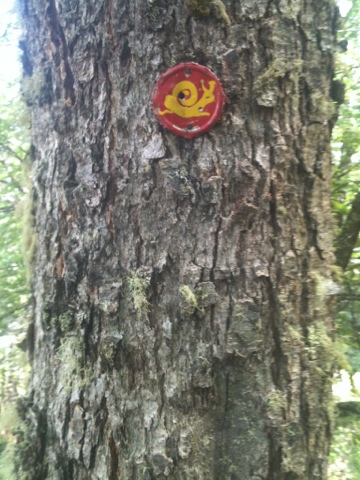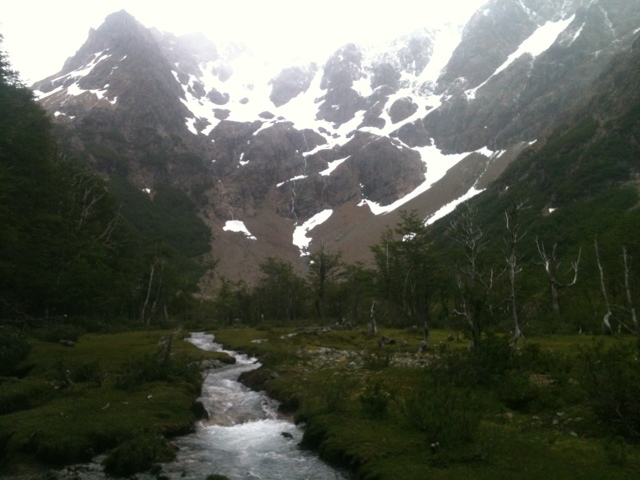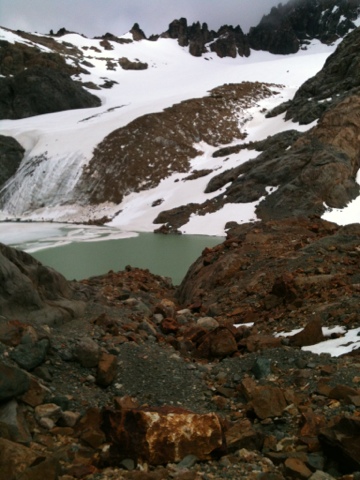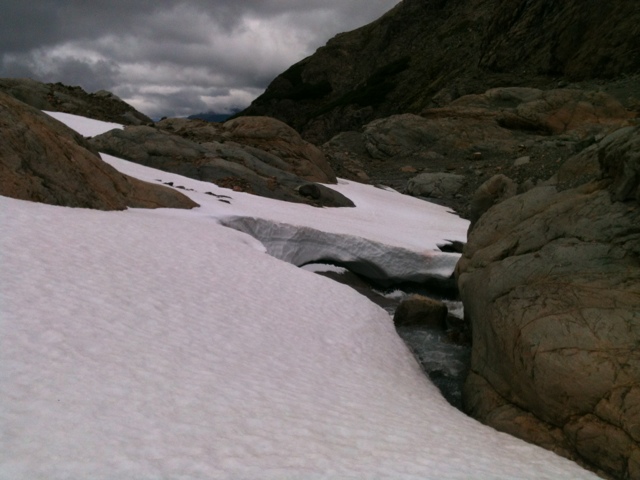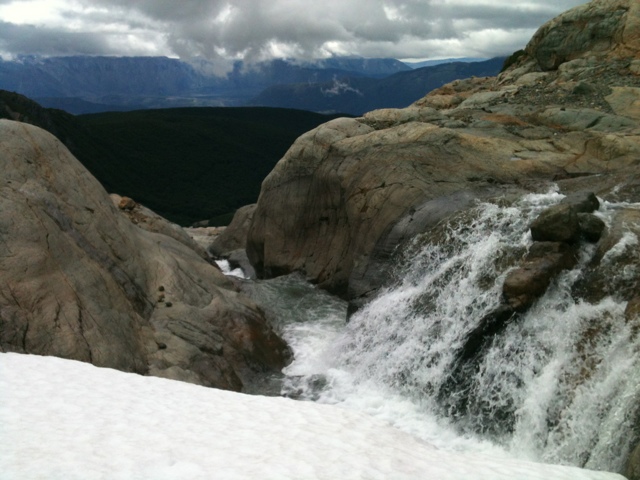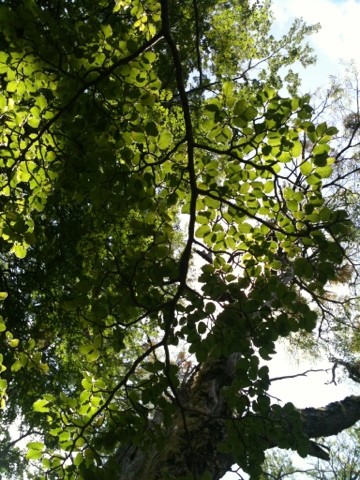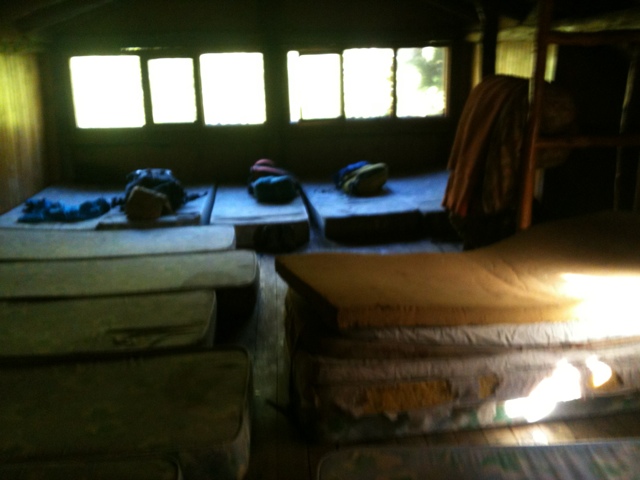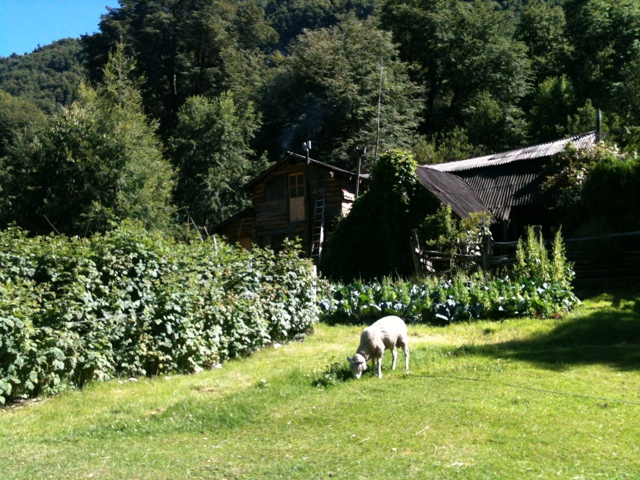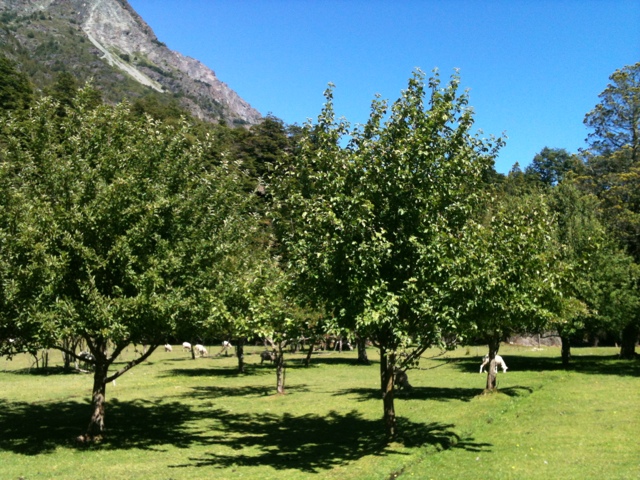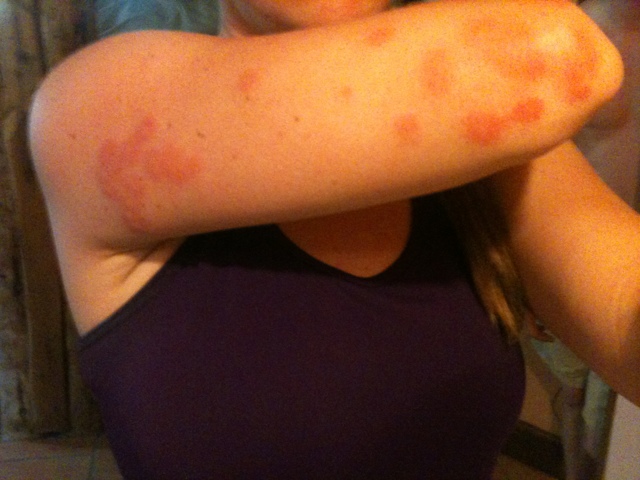We came to Puerto Natales over a week ago so that we could visit Torres Del Paine National Park. I expected it to be a big town for some reason. It is the location where ferries from the North (Puerto Montt) start and end. Chile doesn't have a road that connects the Southern part of the country to the Northern portion. The stretch where there is no road is a place where the Andes are too close to the coast leaving little room to build a highway, there are also fjords, islands, glaciers and the Southern Patagonian ice field making it even more difficult. Unless you travel through Argentina, the only way to get to Northern Chile from here is by ferry or airplane. Earlier in the trip we had considered taking this ferry because we hear it is very scenic, but we have run out of time.
Puerto Natales is smaller and more isolated than I had expected. They usually have cloudy cool weather and lots of wind. None of the buildings appear to be more than two stories high, and all of them have an exterior of brightly painted sheet metal. There are tons of tourists here because this is the gateway to Torres del Paine National Park and most people spend a night or two here on their way in and out of the park. Even with all the tourism money coming in, the town appears to be depressed and many of the houses as neighborhoods run down.
We took a bus into Torres Del Paine on Wednesday afternoon. It's about a 2 1/2 hour ride from Puerto Natales, a lot of it being on dirt road. We saw hundreds of guanacos on the way! Our plan was to do the W trek, which as named as such because on a map the route follows a W shaped path. It can be done in 3 days, but we decided to go easy and do it in 4 days. The route follows around the base of the Torres (Towers) and Cuernos (horns) which form a mountain range unique from the Andes. The park is a UNESCO biosphere reserve and contains 17 different ecosystems! There are multiple milky blue green glacially fed lakes and rivers, many glaciers and rocks and mountains everywhere. The rock is particularly interesting because you can see layers and patterns in the cliffs and mountains where glaciers have carved away and the towers and Cuernos (which the park is famous for) are composed of layers of granite and compressed sedimentary rock (which looks like basalt but is not). Surrounding all the rocks, mountains and glaciers are the rolling green hills and flat grasslands of the steppe. It is all very visually pleasing. (:
We had phenomenal weather every day. Mostly blue skies and little wind with clean mountain views and it wasn't too hot either! This is unusual most people have to deal with clouds, high winds and rain. We never saw any rain. In total we hiked about 60 miles and are quite tired now, and looking forward to rest. We were able to pack really lightly though, because there are refuges along the trail, so we didn't have to bring camping gear. The refuges are extremely nice compared to ones we have previously stayed in. They are like deluxe hostels contained inside of a log cabin and you can even get all your meals from them! They are very expensive, around $50 per person for a bunk bed and $50 per person for full board (meals). All of the refuges are privately owned and they can get away with it! The trip was very hard to plan because there are many different options for where to start and how long you will hike each day and where you will end up each night. There is also the option of renting camping gear in town and camping the whole way, as there are a few free camp sites. We decided we'd rather hike with little weight so we stayed in refuges and purchased all the meals.
Here is a link to a map of the w trek. This is a map someone else made and not the same order we did our trek in.
https://blogger.googleusercontent.com/img/b/R29vZ2xl/AVvXsEgR8uInSQjZ7uJ91tVRtn0dg8w2ymtmMO40dHCOfwRyCfznn8aM54i49zZG6lGiSndDfP77FlEkVuXcQSUxVvqDdfpEOoHi0kXN5ZG7oWPvGIfzirBmGvlAuIznLrHzAh9Xfz6XnnryIX9z/s1600/w+trek+map+torres+del+paine+5.jpg
The first day was a 3 1/2 hour hike from the park entrance to a lookout out point at the base of the towers, which included glaciers and a lagoon below and then 2 hours partway down the mountain to Refugio Los Chilenos. The second day was a 6 hour hike along the length of a large mint green glacier lake (Nordenskjold) to Refugio Los Cuernos, which sits just below the Cuernos (which are black on top yellowish on bottom, the black is sedimentary, the yellowish is granite). Day three we hiked from Los Cuernos, up the glacier filled French Valley (where we watched multiple avalanches) and back out to Refugio Paine Grande. It was a long day, at ten hours. The Paine Grande Refuge was by far the nicest place we stayed in the park and the lodging and food there put the others to shame. On the fourth and final day, we hiked four hours from the refuge along a greenish grey glacier lake to a cove where we had a view of Glacier Grey, a tidewater glacier. It was extremely windy for most of the hike, but we figured it was normal. We took the same route back to the refuge where we were supposed to get a boat across Lago Pehoé and out of the park. On the walk back the winds got worse and worse. It was at our backs on the return as we could feel it pushing us. By the time we made it back to the refuge the wind was forcing us to walk at 45 degree angle. And we watched a fancy North Face mountaineering tent get blown out of the camping area next to the refuge. It was ripped open and almost blown into the lake. The lake was a mess of mist and vapor, as the surface of the water was being blown off. Still we thought this was normal! We have heard over and over that the winds in Patagonia could be crazy. It turned out it was too windy for the boat to run and 50 people, including us, were stranded until the following day! The only way out was by hiking 5 hours to the administration building, which would do us no good, as there would be no bus when we got there, and we were also exhausted and it would get dark soon. The people at the lodge could only remember this happening one other time! We were amongst the lucky people claiming a couch and window box to sleep in. Jeff took the couch and I took the back cushions and put them in the window box. We were quite comfortable, and the lodge didn't charge us to sleep there. Some had tents and others we not so lucky and slept on the floor of the ranger hut, which overflowed with bodies. It was a big mess.
The next day we got up early and decided to skip the boat, saving $50. We took the mostly flat five hour (10 mile) long trail to administration. It ended up being a nice hike we had lovely views of the towers and Cuernos from far away and we walked through grassy golden meadows that rippled in the wind.
We didn't get back to Puerto Natales until 5 pm last night. We had missed our morning bus to Punta Arenas and all the evening buses were sold out. We had no choice but to stay another night. We were lucky our hostel, which was storing our luggage had been able to fill our spot and didn't charge us for the night we missed. But I don't think we will be so lucky with the place in Punta Arenas. We also had to push back our bus tickets from Punta Arenas to Ushuaia (the last stop on our trip) and move our hostel reservations back as well. It was a big headache for me.
Even with all the mess at the end of our trek, we had a great time and couldn't have asked for better weather! I am afraid to ever go back because I don't believe we could ever be so lucky again!
We got up early this morning and are en route to Punta Arenas. It's a short three hour ride. We will spend three nights and three days in Punta Arenas. The highlight will be a visit to the National Monument of Penguins at Magdalena Island, with 50,000 breeding pairs on penguins!! (:
** I wrote this blog 2 days ago Tuesday but was until this moment not able to connect to the wifi at our hostel (Hospedaje Costanera).
Thursday, January 31, 2013
Monday, January 21, 2013
El Calafate
Our first day in El Calafate we did little. We sat around recovering from the exhaustion of endless hiking in El Chaltén. Our hostel was a little ways out side of the center so we walked to town to get groceries and to the bus station to get onward tickets and that was it. El Calafate is much larger than El Chaltén was, but it is also a relatively new town. The oldest building was from 1949! The town sits on the shore of Lago Argentino, which is an enormous glacier lake. It's largest in Argentina and you can see it in satellite images from outer space! It's a lovely milky blue green color, and with our hostel being up on a hill, we had very nice views of it. Nearby there was a wetland along the shore that we planned to visit, because they have wild flamingos,(!!!) but we were too lazy and it was hot and sunny out again.
The main reason people go to El Calafate is to see the glaciers along the lake, none of which you can see from town. You have to drive about an hour west along the lake toward the Andes and into Parque Nacional Los Glaciares South. The lake and mountains in this part of the park border the gigantic Patagonian ice cap and many glaciers can be seen. The most famous glacier to visit is Perito Moreno. It's not even the largest one along the lake, but it's certainly the most impressive because of how close you can get to it at the various view points that have been set up. It's also famous because it advances, sometimes so much that it makes it across the lake and separates the lake into two parts, creating an ice dam! When this happens, about every year or so, the force of the trapped water creates a tunnel through the ice and eventually the tunnel breaks. Both the creation and the breaking of the tunnel are very exciting to see. We went yesterday to see the glacier, and the tunnel had ruptured the day before!!!
We visited the glacier on a tour, so we only had about an hour to view the glacier. Many people will sit for hours and watch. It's constantly thundering and calving off large ice bergs into the large. The park service has created a series of boardwalks for people to walk along and see all different angles of the glacier. It has 2 faces, North and South, and the South face alone is 2 km wide and it extends back 27 km and at the face, it's as tall as a 20 story building! We had another clear, hot and sunny day and we could see all the way back into the mountains where the glacier was coming from. It was mind blowing!
The focus of our tour was ice trekking, so after our short visit to the viewing platforms, we took a boat across the lake and began hiking up a rocky lateral moraine alongside the glacier. After about 45 minutes of going up we strapped on crampons and began walking across the glacier. We learned some interesting things about glaciers that I never knew! There are rivers of melt water running on top of the glacier and the water escapes to the bottom of the glacier through holes in the ice, this creates nice water falls. There are rocks on the glacier, that the glacier itself kicks up while it moves. The rocks get hot in the sun and create long tube like melt holes in the ice. There is a bug that lives on the glaciers! And melt water along the side of the glacier can build up if it has no escape route, so sometimes you will see a high water mark alongside a glacier where a lake once was until the water broke through the ice! We got to spend a little over 3 hours on the ice walking over hills and around crevasses and into valleys and along rivers. We ultimately reached a high view point and then turned back. It was a very fun and unique experience.
We are now in Puerto Natales, Chile. The bus ride was about five hours, but we spent an additional two hours at customs checking out of Argentina and into Chile. It takes forever with a bus load of people, and we had another bus in front of ours! We will spend about a week here visiting the main attraction, Torres del Paine National, and hiking the 4 day W circuit inside the park. The mountains in Torres del Paine are similar looking to what we saw in El Chaltén, granite spires and towers, but the fauna should be much different as the rain fall is quite a lot higher on the Chilean side of the Andes. And we have the chance to see guanacos, rheas (the ostrich birds) and flamingos during our hike!
The main reason people go to El Calafate is to see the glaciers along the lake, none of which you can see from town. You have to drive about an hour west along the lake toward the Andes and into Parque Nacional Los Glaciares South. The lake and mountains in this part of the park border the gigantic Patagonian ice cap and many glaciers can be seen. The most famous glacier to visit is Perito Moreno. It's not even the largest one along the lake, but it's certainly the most impressive because of how close you can get to it at the various view points that have been set up. It's also famous because it advances, sometimes so much that it makes it across the lake and separates the lake into two parts, creating an ice dam! When this happens, about every year or so, the force of the trapped water creates a tunnel through the ice and eventually the tunnel breaks. Both the creation and the breaking of the tunnel are very exciting to see. We went yesterday to see the glacier, and the tunnel had ruptured the day before!!!
We visited the glacier on a tour, so we only had about an hour to view the glacier. Many people will sit for hours and watch. It's constantly thundering and calving off large ice bergs into the large. The park service has created a series of boardwalks for people to walk along and see all different angles of the glacier. It has 2 faces, North and South, and the South face alone is 2 km wide and it extends back 27 km and at the face, it's as tall as a 20 story building! We had another clear, hot and sunny day and we could see all the way back into the mountains where the glacier was coming from. It was mind blowing!
The focus of our tour was ice trekking, so after our short visit to the viewing platforms, we took a boat across the lake and began hiking up a rocky lateral moraine alongside the glacier. After about 45 minutes of going up we strapped on crampons and began walking across the glacier. We learned some interesting things about glaciers that I never knew! There are rivers of melt water running on top of the glacier and the water escapes to the bottom of the glacier through holes in the ice, this creates nice water falls. There are rocks on the glacier, that the glacier itself kicks up while it moves. The rocks get hot in the sun and create long tube like melt holes in the ice. There is a bug that lives on the glaciers! And melt water along the side of the glacier can build up if it has no escape route, so sometimes you will see a high water mark alongside a glacier where a lake once was until the water broke through the ice! We got to spend a little over 3 hours on the ice walking over hills and around crevasses and into valleys and along rivers. We ultimately reached a high view point and then turned back. It was a very fun and unique experience.
We are now in Puerto Natales, Chile. The bus ride was about five hours, but we spent an additional two hours at customs checking out of Argentina and into Chile. It takes forever with a bus load of people, and we had another bus in front of ours! We will spend about a week here visiting the main attraction, Torres del Paine National, and hiking the 4 day W circuit inside the park. The mountains in Torres del Paine are similar looking to what we saw in El Chaltén, granite spires and towers, but the fauna should be much different as the rain fall is quite a lot higher on the Chilean side of the Andes. And we have the chance to see guanacos, rheas (the ostrich birds) and flamingos during our hike!
Saturday, January 19, 2013
El Chaltén
The 22 hour bus ride to El Chaltén turned out to be a 23 hour ride, but it really wasn't so bad. The bus wastes a lot of time detouring to towns that are off the highway, if it was direct it would be a much shorter ride. We were able to sleep through a lot of it. Unfortunately the bus wasn't a very nice one, no special seats or anything but we survived. The drive was South along route 40, which is like the Argentinian version of Route 66. South of Esquel there is pretty much nothing for a very long time. The scenery is mostly flat desert with small grass like plants covering the ground. We saw tons of guanacos (llama like animals) and we even saw rheas, which are like miniature ostriches!
We spent 3 days and 3 nights in El Chaltén and we stayed busy hiking from the moment we woke up until we went to bed each night. We are quite far South now, and the days are very long. It doesn't get fully dark until after 10. We went on a hike each day that we were there, and we got glorious cloudless skies and no wind which is apparently not so common. There is a downside to this, however, no clouds made it rather hot, as did no wind. But no wind also means you will have an army of enormous horseflies buzzing and orbiting your head most of the time that you are hiking! We did and that part was very unenjoyable!
The mountain range that we were hiking around is known as the Fitz Roy range, which consists of several granite towers which rise out of the flattish surrounding desert land. Since we had cloudless days we had no problem seeing all of the towers and spires of the range and it was amazing hiking scenery, probably never seen better in my life. The range is protected, and all of the hikes are within Parque Nacional Los Glacieres (North).
The town of El Chaltén is the youngest in Argentina and it still quite small, very expensive and strange. It was literally thrown together in 1985 so that Argentina could stake claim on the land before Chile did. It sits in a valley between two glacier rivers at the foot of the Fitz Roy range.
Each day our hikes got longer. We started with a 6 hour day to Laguna Torre, which takes you through dwarf ñire and lenga forests (Southern Beech varieties) and along the Río Fitz Roy to a large glacial lagoon. The greenish waters of the lagoon are from the del Torre glacier which sits at the base of one of the granite spires which is named The Tower. From this place you can see many other towers as well, but not Fitz Roy, the tallest one (3405 m). You can also see several other glaciers.
The second day we did a 7 hour hike up a mountain called Loma del Pliegue Tumbado. It was hot out and it was uphill the whole way, but from the top the views were amazing. Many hikes are described as having 360 views but this one really did. Everywhere you looked there were glaciers, mountains, rivers or lakes to look at. We could see the whole Fitz Roy range and probably 20 glaciers, and again no clouds! It was spectacular! The scenery on the way up was pretty too, we had views of town and we passed through many pretty meadows. One of the meadows had some very happy cows grazing in it! It is strange to me that no matter where we are on a hike, the cows are never far away.
The third day was an 8 hour day to Laguna de Los Tres. This hike was on the other side of the mountain range from our two previous days of hiking, and had fantastic views of Fitz Roy. We took a shuttle a little ways North of town so that we could do a through hike instead of out and back from town. This was nice because it allowed for more downhill than uphill, but we were still ready to drop dead by the end of the day! The downside of doing this was that a million other people started the hike at the same time we did. We walked along the Río Blanco through the nice shade of the forest with many views of glaciers, mountains and river along the way. The highlight of this part of the walk was seeing the Piedras Blancas glacier from across the river. It had a pool of water around it being held in by piles of rocks and there was a huge water fall pouring out the of the glacier. After 2 hours we came to the base of the up portion. It was a very steep, rocky, hot, dusty, shade less hour and a half from there, but it was all worth it when we got to the top. We could see two glacial lagoons, Laguna de Los Tres and a second one that we hadn't expected to see, Laguna Sucia! One was a milky turquoise green color and the other was a clear bright blue that I have never seen in water before! The lagoons were surrounded by a half moon of rocky mountains, tower and spires and blue glaciers. It was absolutely phenomenal. The walk back was nice, very different landscape from the start of the hike. It looked like Utah with red rock and desert plants!
The water in rivers and streams here, and everywhere we've been is so clean you can drink from them. So we've been partaking of the water along the way, it is quite nice because you don't have to carry so much and you can drink as much as you like without feeling like you have to ration it!
The cell phone pictures really won't do justice to the scenery we saw. And for the Laguna los Tres hike the view was so big I had to take separate pictures of each lagoon. You will have to use your imagination to piece them together.
We took a bus last night 2 1/2 hours South to El Calafate where we will visit Parque Nacional Los Glacieres (South). This place is home to the enormous Perito Moreno Glacier! We will be here 3 nights and staying at the America Del Sur hostel.
We spent 3 days and 3 nights in El Chaltén and we stayed busy hiking from the moment we woke up until we went to bed each night. We are quite far South now, and the days are very long. It doesn't get fully dark until after 10. We went on a hike each day that we were there, and we got glorious cloudless skies and no wind which is apparently not so common. There is a downside to this, however, no clouds made it rather hot, as did no wind. But no wind also means you will have an army of enormous horseflies buzzing and orbiting your head most of the time that you are hiking! We did and that part was very unenjoyable!
The mountain range that we were hiking around is known as the Fitz Roy range, which consists of several granite towers which rise out of the flattish surrounding desert land. Since we had cloudless days we had no problem seeing all of the towers and spires of the range and it was amazing hiking scenery, probably never seen better in my life. The range is protected, and all of the hikes are within Parque Nacional Los Glacieres (North).
The town of El Chaltén is the youngest in Argentina and it still quite small, very expensive and strange. It was literally thrown together in 1985 so that Argentina could stake claim on the land before Chile did. It sits in a valley between two glacier rivers at the foot of the Fitz Roy range.
Each day our hikes got longer. We started with a 6 hour day to Laguna Torre, which takes you through dwarf ñire and lenga forests (Southern Beech varieties) and along the Río Fitz Roy to a large glacial lagoon. The greenish waters of the lagoon are from the del Torre glacier which sits at the base of one of the granite spires which is named The Tower. From this place you can see many other towers as well, but not Fitz Roy, the tallest one (3405 m). You can also see several other glaciers.
The second day we did a 7 hour hike up a mountain called Loma del Pliegue Tumbado. It was hot out and it was uphill the whole way, but from the top the views were amazing. Many hikes are described as having 360 views but this one really did. Everywhere you looked there were glaciers, mountains, rivers or lakes to look at. We could see the whole Fitz Roy range and probably 20 glaciers, and again no clouds! It was spectacular! The scenery on the way up was pretty too, we had views of town and we passed through many pretty meadows. One of the meadows had some very happy cows grazing in it! It is strange to me that no matter where we are on a hike, the cows are never far away.
The third day was an 8 hour day to Laguna de Los Tres. This hike was on the other side of the mountain range from our two previous days of hiking, and had fantastic views of Fitz Roy. We took a shuttle a little ways North of town so that we could do a through hike instead of out and back from town. This was nice because it allowed for more downhill than uphill, but we were still ready to drop dead by the end of the day! The downside of doing this was that a million other people started the hike at the same time we did. We walked along the Río Blanco through the nice shade of the forest with many views of glaciers, mountains and river along the way. The highlight of this part of the walk was seeing the Piedras Blancas glacier from across the river. It had a pool of water around it being held in by piles of rocks and there was a huge water fall pouring out the of the glacier. After 2 hours we came to the base of the up portion. It was a very steep, rocky, hot, dusty, shade less hour and a half from there, but it was all worth it when we got to the top. We could see two glacial lagoons, Laguna de Los Tres and a second one that we hadn't expected to see, Laguna Sucia! One was a milky turquoise green color and the other was a clear bright blue that I have never seen in water before! The lagoons were surrounded by a half moon of rocky mountains, tower and spires and blue glaciers. It was absolutely phenomenal. The walk back was nice, very different landscape from the start of the hike. It looked like Utah with red rock and desert plants!
The water in rivers and streams here, and everywhere we've been is so clean you can drink from them. So we've been partaking of the water along the way, it is quite nice because you don't have to carry so much and you can drink as much as you like without feeling like you have to ration it!
The cell phone pictures really won't do justice to the scenery we saw. And for the Laguna los Tres hike the view was so big I had to take separate pictures of each lagoon. You will have to use your imagination to piece them together.
We took a bus last night 2 1/2 hours South to El Calafate where we will visit Parque Nacional Los Glacieres (South). This place is home to the enormous Perito Moreno Glacier! We will be here 3 nights and staying at the America Del Sur hostel.
Sunday, January 13, 2013
Esquel
Something that we have found rather annoying throughout this trip is that when you travel by bus you are not allowed to load or unload your own bag. You have to wait in line behind everyone else that was on the bus while some random guy not even affiliated with the bus company hands you your bag, that you could have just as easily grabbed your self. Then you are expected to tip and they will ask you for money if you don't readily offer it and if you pretend not understand they will show you money and say in English, tip for my salary! This really blows because is hard to keep small bills around for such occasions. We usually have the Argentinian equivalent of $20 bills, and it's not like we'd tip that much! This is what happened to us when we got off the bus at Esquel. We saw some other people grab their own bags, cause the line was taking forever. So we grabbed ours and started walking away. The luggage man, who had some sort of speech impediment, started chasing after us and shrieking and showing us money. He wanted a tip even though he never touched our bags! We didn't have any small bills so we just stood there staring at him while he shrieked and eventually gave up. It was very awkward. If Jeff and I had a dollar for every bag we ever loaded into a bus, we'd be multi millionaires! Plus the bags we load are about 5 times heavier and more difficult to move around than our than our backpacks!
We have now been in Esquel 3 days. We hadn't intended to stay so long but the bus to our next destination (El Chaltén) wasn't until today, Monday.
There's nothing really to do inside the town of Esquel and not many tourists come here, but there's something very pleasant and peaceful about it. I really liked it here. In a way it reminds me of San Martín de Los Andes, with many nice houses, lots of them A frame cabins with yards full of pretty flowers. The town is surrounded by low mountains and hills. And they take siesta very serious! The streets become deserted and everything closes from about 2 to 6!
Our first day we did just about nothing since we are still sick and wished to rest. We took a nice walk to the bus station to buy our onward tickets and also to book a tour to visit Los Alerces National Park. On the way back we found a nice pine tree with a perfect nest for people, so we climbed up and took a rest. When we got back to the hostel (Casa del Pueblo) we had a nap and then spent the rest of the evening in the hammocks.
The next day we took a bus to the nearby town of Trevelin, which is a Welsh settlement. There are many Welsh settlements in Patagonia and some of the people in these towns still speak Gaelic! They also still serve traditional Welsh tea service, and this is precisely why we went to Trevelin, to visit a tea house. I am still having difficulty understanding Patagonian Spanish so when we entered the tea house (Nain Maggie) and the lady asked us if we wanted complete tea service we just blindly agreed and didn't ask questions! I thought it was pretty cool she brought out fancy tea cups and a big pot of tea, and a little carafe of milk, a plate of cheese, four slices of bread which is made with flour they grind at their own mill, locally produced cherry jam and butter and two scones. Another 10 minutes later she brought out another plate, this time full of cakes and pastries, five different kinds and two of each kind! It was an incredible amount of food, more than we could eat for sure! We could have shared a serving! We also prefer to call these things un-sweets because although they looked like desserts they were not sweet! There was something called black cake which looked like a black fruit cake and tasted like it was dipped in whiskey! Not good! There was also some sort of sour apple pie type thing, a sour raspberry tart sort of thing, something that resembled flan pie and a piece of very dry chocolate cake. It was all quite strange to us. We only ate half of them and we got the rest to go on a paper plate, which I ate on our tour the next day. Jeff was not impressed and didn't want anything to do with them! I didn't care for them much either but we paid for them and I don't like to waste! We we paid the bill we were quite surprised that the tea service cost $20 each!! By far the most expensive meal we have had in Argentina! After tea time I was on absolute carb overload and we went and took a rest in the shady grass of the local park before returning to Esquel! We had corn flakes and white bread with dulce de leche (caramel spread) for breakfast, I think I am becoming malnourished on this trip! Too much bread!!!
Today is our third and last day in Esquel and we went on a boat tour of Los Alerces National Park. It was a very expensive park to visit. Including the park entrance fee, boat ride and transportation it cost us $107 each, which is double the cost of any other tour we have done! The main attraction in the park is to see the Alerce trees that the park is named for, and more specifically the Abuelo or grandpa tree, which is 2,600 years old! The only way to do this is to take the boat, as there are no trails into the area of the park where the Abuelo is located. We had 2 separate boat rides to take to get the ancient alerce forest. The first was about an hour and a half ride down Lago Futulaufquen, up the 3.5 km long Río Arrayanes and into Lago Verde. It was a very scenic ride across a very deep glassy glacier lake. The surrounding hills and mountains were reflected perfectly into the lake. The part on the river was pretty cool because you can see the bottom the whole time as it barely meets the depth requirement of 90 cm for the boat to pass through, so they zig zag around avoiding sand bars. The shore in this part is lined with the red orange barked Arrayán trees, some of them are growing right out of the turquoise water like mangroves. After the first ride we had to get off the boat and walk 1 km to Lago Menendez and board a second boat. It was another glassy glacier lake and this time we could see a glacier and snowy mountains along the border with Chile. After another 1 on this boat we disembarked in the Alerce forest. Unfortunately our boat had 80 people on it and there was another boat there with just as many people aboard! It was ridiculous. This was the part of the trip we had been most looking forward to. They split the groups into "small" groups of 40 and tried to stagger us down the trail. We probably walked no more than half a mile and it took us an hour doing baby steps the whole way! And sadly the forest had been logged until 1937, so there were very few Alerce trees! The wood was seen as very valuable, as it is extremely rot resistant and used to build roofs, flooring, houses, boats, etc. We only saw three trees that were over 1,000 years old and a small hand full of younger trees. The Alerce trees are very similar looking to the Giant Sequoia trees, but they are extremely slow growers. We saw one tree that was probably 2 feet tall with a trunk of maybe a centimeter and the guide said it was probably 40 years old! They only grow a few millimeters a year at most! They are the second oldest living trees on earth behind bristlecone pine trees!
Our entertainment for the walking part of the tour was seeing all the silly Argentinians photographing each other with every random tree, fallen tree or trunk. They make really ridiculous sexy poses, especially the ladies, but the guys too! (We were the only foreigners on the boat).
After the brief forest walk we boarded the boat and had to do the same thing all over again, only this time it was blazing hot and miserable!
We are now back at our hostel. In two hours we will board a 22 hour bus ride South to El Chaltén, the trekking capital of Patagonia. It is a very busy place and we plan to stay for 3 days. We had to make reservations at two different hostels because there wasn't a single place in town that had room for us all three nights! The first night will be at Rancho Grande Hostel and the second two at Aylen-Aike Hostel.
*I have included a photo of a monkey puzzle tree! (Araucaria araucana)
We have now been in Esquel 3 days. We hadn't intended to stay so long but the bus to our next destination (El Chaltén) wasn't until today, Monday.
There's nothing really to do inside the town of Esquel and not many tourists come here, but there's something very pleasant and peaceful about it. I really liked it here. In a way it reminds me of San Martín de Los Andes, with many nice houses, lots of them A frame cabins with yards full of pretty flowers. The town is surrounded by low mountains and hills. And they take siesta very serious! The streets become deserted and everything closes from about 2 to 6!
Our first day we did just about nothing since we are still sick and wished to rest. We took a nice walk to the bus station to buy our onward tickets and also to book a tour to visit Los Alerces National Park. On the way back we found a nice pine tree with a perfect nest for people, so we climbed up and took a rest. When we got back to the hostel (Casa del Pueblo) we had a nap and then spent the rest of the evening in the hammocks.
The next day we took a bus to the nearby town of Trevelin, which is a Welsh settlement. There are many Welsh settlements in Patagonia and some of the people in these towns still speak Gaelic! They also still serve traditional Welsh tea service, and this is precisely why we went to Trevelin, to visit a tea house. I am still having difficulty understanding Patagonian Spanish so when we entered the tea house (Nain Maggie) and the lady asked us if we wanted complete tea service we just blindly agreed and didn't ask questions! I thought it was pretty cool she brought out fancy tea cups and a big pot of tea, and a little carafe of milk, a plate of cheese, four slices of bread which is made with flour they grind at their own mill, locally produced cherry jam and butter and two scones. Another 10 minutes later she brought out another plate, this time full of cakes and pastries, five different kinds and two of each kind! It was an incredible amount of food, more than we could eat for sure! We could have shared a serving! We also prefer to call these things un-sweets because although they looked like desserts they were not sweet! There was something called black cake which looked like a black fruit cake and tasted like it was dipped in whiskey! Not good! There was also some sort of sour apple pie type thing, a sour raspberry tart sort of thing, something that resembled flan pie and a piece of very dry chocolate cake. It was all quite strange to us. We only ate half of them and we got the rest to go on a paper plate, which I ate on our tour the next day. Jeff was not impressed and didn't want anything to do with them! I didn't care for them much either but we paid for them and I don't like to waste! We we paid the bill we were quite surprised that the tea service cost $20 each!! By far the most expensive meal we have had in Argentina! After tea time I was on absolute carb overload and we went and took a rest in the shady grass of the local park before returning to Esquel! We had corn flakes and white bread with dulce de leche (caramel spread) for breakfast, I think I am becoming malnourished on this trip! Too much bread!!!
Today is our third and last day in Esquel and we went on a boat tour of Los Alerces National Park. It was a very expensive park to visit. Including the park entrance fee, boat ride and transportation it cost us $107 each, which is double the cost of any other tour we have done! The main attraction in the park is to see the Alerce trees that the park is named for, and more specifically the Abuelo or grandpa tree, which is 2,600 years old! The only way to do this is to take the boat, as there are no trails into the area of the park where the Abuelo is located. We had 2 separate boat rides to take to get the ancient alerce forest. The first was about an hour and a half ride down Lago Futulaufquen, up the 3.5 km long Río Arrayanes and into Lago Verde. It was a very scenic ride across a very deep glassy glacier lake. The surrounding hills and mountains were reflected perfectly into the lake. The part on the river was pretty cool because you can see the bottom the whole time as it barely meets the depth requirement of 90 cm for the boat to pass through, so they zig zag around avoiding sand bars. The shore in this part is lined with the red orange barked Arrayán trees, some of them are growing right out of the turquoise water like mangroves. After the first ride we had to get off the boat and walk 1 km to Lago Menendez and board a second boat. It was another glassy glacier lake and this time we could see a glacier and snowy mountains along the border with Chile. After another 1 on this boat we disembarked in the Alerce forest. Unfortunately our boat had 80 people on it and there was another boat there with just as many people aboard! It was ridiculous. This was the part of the trip we had been most looking forward to. They split the groups into "small" groups of 40 and tried to stagger us down the trail. We probably walked no more than half a mile and it took us an hour doing baby steps the whole way! And sadly the forest had been logged until 1937, so there were very few Alerce trees! The wood was seen as very valuable, as it is extremely rot resistant and used to build roofs, flooring, houses, boats, etc. We only saw three trees that were over 1,000 years old and a small hand full of younger trees. The Alerce trees are very similar looking to the Giant Sequoia trees, but they are extremely slow growers. We saw one tree that was probably 2 feet tall with a trunk of maybe a centimeter and the guide said it was probably 40 years old! They only grow a few millimeters a year at most! They are the second oldest living trees on earth behind bristlecone pine trees!
Our entertainment for the walking part of the tour was seeing all the silly Argentinians photographing each other with every random tree, fallen tree or trunk. They make really ridiculous sexy poses, especially the ladies, but the guys too! (We were the only foreigners on the boat).
After the brief forest walk we boarded the boat and had to do the same thing all over again, only this time it was blazing hot and miserable!
We are now back at our hostel. In two hours we will board a 22 hour bus ride South to El Chaltén, the trekking capital of Patagonia. It is a very busy place and we plan to stay for 3 days. We had to make reservations at two different hostels because there wasn't a single place in town that had room for us all three nights! The first night will be at Rancho Grande Hostel and the second two at Aylen-Aike Hostel.
*I have included a photo of a monkey puzzle tree! (Araucaria araucana)
Friday, January 11, 2013
El Bolsón
We spent a week in El Bolsón and wish to someday come back, possibly during the fall when all the trees are red. There are so many outdoor activities nearby, and we did many of them, but there are still more that we are leaving for next time.
The first day it poured rain the entire day. We didn't know what to do with ourselves, so we mostly slept. It was probably good for us to sleep since most of the rest of the trip will be non stop hiking, and Jeff was also getting sick with a cold. The hostel we stayed in (La Casona de Odile) was just as nice as we thought it would be. It has a very nice big backyard on the river filled with weeping willows and birches and many hammocks for resting in. And also includes a nice breakfast of homemade wheat toast and strawberry jam and cereal. (We are still getting used to small breakfasts!) The only downside is that it's a few miles outside of town, but this luckily kept most of the annoying hippies away. (:
On the second day (Monday) we began a three day trek in the mountains. We did not bring a tent on this trip, but most wilderness areas in Argentina have refugios, little cabins out in the middle of nowhere for eating and sleeping in. It was a somewhat expensive taxi ride to the trail head but we split the cost with an older Argentinian man (César) who was also staying in our hostel. Over the three days we hiked a little with him but not the whole time. He was pretty cool, told us a lot about plants along the way and other interesting facts about Argentina.
A story I found particularly interesting was about these obnoxious flys that buzz around your head when you hike here. They are called Tábanos and César says that the water here (rivers and lakes) is so pure that it doesn't even contain salt, so these flys want to land on you and have some of your salt. That is easier said than done though as they are quite scary looking and you instinct is to swat them away. If you let them have your salt they won't bite but if you hit them you better make sure they're dead César says or they'll come back to bite you! About 15 years ago the Argentine government introduced yellow jacket (bees), which are carnivorous, in an attempt to get rid of Tábanos. The Tábanos are still here and now the yellow jackets are also around as pests who attack families during their weekly barbeque parties because they too want a share of the meat! (:
Our trek started with a crossing of this rickety suspension bridge over the Río Azul. It is such a decrepit bridge that only one person can go at a time and you feel that the boards might snap under your feet! Throughout the 3 days we crossed over several more of these. One safely across, the hike was mostly steep up hill and a bit unpleasant because we wasted about an hour being lost climbing up over and around fallen trees, which was exhausting. We made our way back to the bridge having no idea how we missed the big red and yellow arrow stating Refugio this way! From there the trail was easily followed by the red and yellow painted lids from canned foods! We had expected the hike to take 7 hour but were most pleasantly surprised when we arrived after only 5 hours. The closer we got to the refugio, the prettier the forest got, it mostly consisted of lenga, and type of beech and was draped in lichen. The lenga trees have the most perfect arrangement of leaves for creating shade, each branch makes a perfect fan of leaves. The whole day had been cloudy and a tiny bit sprinkly which made the hike more bearable because it wasn't too hot.
The Refugio is called Hielo Azul (Blue Ice) and was built by the Andean Mountain club. It's a little log cabin in a pretty forested valley next to a clear glacier stream and it sits at the base of a horseshoe of rocky cliff like mountains, which still have snow on them. A short but steep hike from the Refugio is a glacier. We waited until day two to see it. The sleeping area in the Refugio is very basic, on the second story of the cabin is a big room with thin foam mats, you bring your own sleeping bag. There must have been at least 40 or more people in there, since it is a refuge the policy is they don't turn anyone away. Many people camp in the yard. They also have hot showers and flush toilets, homemade beer, bread, pizzas and meals. The showers and the cabin are both heated by wood stove. The food and beer was very good. All of it is brought up by horses or on foot by the people that work there! We were pretty amazed by this place, as we have never seen anything like it in the US!
On the second day we did the extremely steep rocky hike up to the glacier. The trail follows closely to the meltwater stream, with many falls along the way. It took us an hour to get up, we spent an hour up there (exploring the area where the water falls over the cliff) and an hour getting down. It wasn't a very big glacier and was very different than any I've ever seen, I suppose because it looked white instead of blue even though it was cloudy. (Glaciers appear more blue on cloudy days). It was surrounded by rocky peaks and and a lovely blue green lagoon, as well as many rocks of interesting color, yellow, purple, brown and rusty red orange. It was a rather taxing hike, but we continued on to the next refuge afterward.
The hike from the Refugio Hielo Azul to the next destination (Refugio Cajón del Azul) was about 5 hours. We had 30 minutes of flat and then a steep uphill for 30 minutes to another refuge that we didn't even know was there, Refugio Laguna Natación)! It was located in a wide flat meadow and surrounded by more of the rocky snow capped mountains that seem to be so common in this area and right on a calm glassy lake. We briefly considered stopping there, but it was so early in the day still and the lady at that refuge told us it was all downhill to Cajón del Azul. So we kept going. We didn't really believe it could be down hill the whole way, but it was! For the first hour or two we had a nice time walking through the forest, but then we came out onto an exposed cliff with excellent views of the Río Azul valley. The clouds were beginning to clear and it was a little hot out and the plant life quickly changed to prickly desert plants, and the downhill was horrendous! So steep and narrow and rocky that there shouldn't have been a trail there. It killed my knees and we were quite exhausted when we finally arrived to the Refugio! Cajón del Azul refers to a narrow canyon which the water from the Río Azul (Blue River) must pass through. At the narrowest it's only about three feet wide and probably 100 ft deep. At this point the trail crosses over it via a rickety log bridge. The Refugio was just on the other side of the river. And as the name suggests the water of the river is a pretty turquoise blue. This Refugio blue te other one out of the water! It was way cool. The guy that built it has lived out in the forest there since 1980. He has fruit trees, including apple and cherry, he grows vegetables, including lettuce and tomatoes and also has sheep for weekend barbeques! It is a big log cabin, much larger than the Refugio Hielo Azul, with a huge dining area. The food was amazing, we had homemade beer, t bone steaks with rice and homemade bread and salad from the garden as wells as salsa and tomato relish from the garden. The sleeping area had real mattresses still shoved into one big room but far more comfortable than the thin foam mats at the first place. Sadly though the bed bugs had a feast on my arm while I slept. I had at least 40 bites when I woke up. It was pretty hot in the place so I slept with my arms exposed and outside of my sleeping bag. :( I have determined that it's been bed bugs biting me all along, it was never a rash. Now I am paranoid that we may be carrying some with us in our backpacks! Jeff is lucky and either doesn't get bit or has no reaction to the bites, some people don't get a reaction, while others like me are allergic!
Despite the bugs we slept very well. Jeff was unfortunately sick with sore throat, cough and fever through out our trek. The clouds really helped us by keeping us cool the first two days. But on the last day hiking back out to the road it was very hot and we were void of energy from that super steep downhill hike the day before. Every muscle in my legs hurt! We passed by many more Refugios, there must have been at least 5 of them along the trail. We had nice shade for awhile but soon we were on a exposed dusty dirt road, which they use to take supplies to the Refugio's along the Río Azul valley. It was three hours out, and towards the end we practically ran trying to catch the bus, which somehow came early and we ended up missing it and taking an expensive taxi back to our hostel. We spent the rest of the afternoon lounging.
I have probably made this trek seem awful but it really was an interesting enjoyable experience, just rather physically taxing, especially with Jeff sick.
The day after we got back we decided to visit the craft market in town. The town is full of hippies, it's where they all escaped to in the 60s and 70s when Argentina was under military rule. At the time Patagonia was sparsely populated and the military didn't care to bother people so far outside of Buenos Aires. Three times a week they have a market here, which is an interesting sight to see. All kinds of handmade crafts items and foods from local farms for sale. There were tons of people lounging in the grass, bands playing and even a trapeze circus show going on. And all the craft stuff was so cool, I wanted everything! They had handmade wool elf shoes, tie died hippie pants, jewelry boxes made out of leaves, and all kinds of cool things carved from wood!
Yesterday we had big plans to see more of the outdoor offerings in El Bolsón. We wanted to visit Lago Puelo National Park and also climb Cerro Piltriquitrón, the tallest mountain in the valley. The mountain is home to an area that was burned by wild fire and local artists came in and carved up all the dead trees into cool statues, bringing new life to the forest. Sadly we saw neither of these as Jeff's illness has now been passed to me and we were just too tired to do anything. It was also over 90 degrees out, so we laid in the hammocks by the river all day. The bright side is now we have in more of a reason to come back. And in the fall the temperatures should be much more enjoyable!
We are now on a bus to Esquel, 2 1/2 hours South of El Bolsón. We may take another rest day and then visit Los Alerces National Park, which is full of very rate and old Alerce trees.
The first day it poured rain the entire day. We didn't know what to do with ourselves, so we mostly slept. It was probably good for us to sleep since most of the rest of the trip will be non stop hiking, and Jeff was also getting sick with a cold. The hostel we stayed in (La Casona de Odile) was just as nice as we thought it would be. It has a very nice big backyard on the river filled with weeping willows and birches and many hammocks for resting in. And also includes a nice breakfast of homemade wheat toast and strawberry jam and cereal. (We are still getting used to small breakfasts!) The only downside is that it's a few miles outside of town, but this luckily kept most of the annoying hippies away. (:
On the second day (Monday) we began a three day trek in the mountains. We did not bring a tent on this trip, but most wilderness areas in Argentina have refugios, little cabins out in the middle of nowhere for eating and sleeping in. It was a somewhat expensive taxi ride to the trail head but we split the cost with an older Argentinian man (César) who was also staying in our hostel. Over the three days we hiked a little with him but not the whole time. He was pretty cool, told us a lot about plants along the way and other interesting facts about Argentina.
A story I found particularly interesting was about these obnoxious flys that buzz around your head when you hike here. They are called Tábanos and César says that the water here (rivers and lakes) is so pure that it doesn't even contain salt, so these flys want to land on you and have some of your salt. That is easier said than done though as they are quite scary looking and you instinct is to swat them away. If you let them have your salt they won't bite but if you hit them you better make sure they're dead César says or they'll come back to bite you! About 15 years ago the Argentine government introduced yellow jacket (bees), which are carnivorous, in an attempt to get rid of Tábanos. The Tábanos are still here and now the yellow jackets are also around as pests who attack families during their weekly barbeque parties because they too want a share of the meat! (:
Our trek started with a crossing of this rickety suspension bridge over the Río Azul. It is such a decrepit bridge that only one person can go at a time and you feel that the boards might snap under your feet! Throughout the 3 days we crossed over several more of these. One safely across, the hike was mostly steep up hill and a bit unpleasant because we wasted about an hour being lost climbing up over and around fallen trees, which was exhausting. We made our way back to the bridge having no idea how we missed the big red and yellow arrow stating Refugio this way! From there the trail was easily followed by the red and yellow painted lids from canned foods! We had expected the hike to take 7 hour but were most pleasantly surprised when we arrived after only 5 hours. The closer we got to the refugio, the prettier the forest got, it mostly consisted of lenga, and type of beech and was draped in lichen. The lenga trees have the most perfect arrangement of leaves for creating shade, each branch makes a perfect fan of leaves. The whole day had been cloudy and a tiny bit sprinkly which made the hike more bearable because it wasn't too hot.
The Refugio is called Hielo Azul (Blue Ice) and was built by the Andean Mountain club. It's a little log cabin in a pretty forested valley next to a clear glacier stream and it sits at the base of a horseshoe of rocky cliff like mountains, which still have snow on them. A short but steep hike from the Refugio is a glacier. We waited until day two to see it. The sleeping area in the Refugio is very basic, on the second story of the cabin is a big room with thin foam mats, you bring your own sleeping bag. There must have been at least 40 or more people in there, since it is a refuge the policy is they don't turn anyone away. Many people camp in the yard. They also have hot showers and flush toilets, homemade beer, bread, pizzas and meals. The showers and the cabin are both heated by wood stove. The food and beer was very good. All of it is brought up by horses or on foot by the people that work there! We were pretty amazed by this place, as we have never seen anything like it in the US!
On the second day we did the extremely steep rocky hike up to the glacier. The trail follows closely to the meltwater stream, with many falls along the way. It took us an hour to get up, we spent an hour up there (exploring the area where the water falls over the cliff) and an hour getting down. It wasn't a very big glacier and was very different than any I've ever seen, I suppose because it looked white instead of blue even though it was cloudy. (Glaciers appear more blue on cloudy days). It was surrounded by rocky peaks and and a lovely blue green lagoon, as well as many rocks of interesting color, yellow, purple, brown and rusty red orange. It was a rather taxing hike, but we continued on to the next refuge afterward.
The hike from the Refugio Hielo Azul to the next destination (Refugio Cajón del Azul) was about 5 hours. We had 30 minutes of flat and then a steep uphill for 30 minutes to another refuge that we didn't even know was there, Refugio Laguna Natación)! It was located in a wide flat meadow and surrounded by more of the rocky snow capped mountains that seem to be so common in this area and right on a calm glassy lake. We briefly considered stopping there, but it was so early in the day still and the lady at that refuge told us it was all downhill to Cajón del Azul. So we kept going. We didn't really believe it could be down hill the whole way, but it was! For the first hour or two we had a nice time walking through the forest, but then we came out onto an exposed cliff with excellent views of the Río Azul valley. The clouds were beginning to clear and it was a little hot out and the plant life quickly changed to prickly desert plants, and the downhill was horrendous! So steep and narrow and rocky that there shouldn't have been a trail there. It killed my knees and we were quite exhausted when we finally arrived to the Refugio! Cajón del Azul refers to a narrow canyon which the water from the Río Azul (Blue River) must pass through. At the narrowest it's only about three feet wide and probably 100 ft deep. At this point the trail crosses over it via a rickety log bridge. The Refugio was just on the other side of the river. And as the name suggests the water of the river is a pretty turquoise blue. This Refugio blue te other one out of the water! It was way cool. The guy that built it has lived out in the forest there since 1980. He has fruit trees, including apple and cherry, he grows vegetables, including lettuce and tomatoes and also has sheep for weekend barbeques! It is a big log cabin, much larger than the Refugio Hielo Azul, with a huge dining area. The food was amazing, we had homemade beer, t bone steaks with rice and homemade bread and salad from the garden as wells as salsa and tomato relish from the garden. The sleeping area had real mattresses still shoved into one big room but far more comfortable than the thin foam mats at the first place. Sadly though the bed bugs had a feast on my arm while I slept. I had at least 40 bites when I woke up. It was pretty hot in the place so I slept with my arms exposed and outside of my sleeping bag. :( I have determined that it's been bed bugs biting me all along, it was never a rash. Now I am paranoid that we may be carrying some with us in our backpacks! Jeff is lucky and either doesn't get bit or has no reaction to the bites, some people don't get a reaction, while others like me are allergic!
Despite the bugs we slept very well. Jeff was unfortunately sick with sore throat, cough and fever through out our trek. The clouds really helped us by keeping us cool the first two days. But on the last day hiking back out to the road it was very hot and we were void of energy from that super steep downhill hike the day before. Every muscle in my legs hurt! We passed by many more Refugios, there must have been at least 5 of them along the trail. We had nice shade for awhile but soon we were on a exposed dusty dirt road, which they use to take supplies to the Refugio's along the Río Azul valley. It was three hours out, and towards the end we practically ran trying to catch the bus, which somehow came early and we ended up missing it and taking an expensive taxi back to our hostel. We spent the rest of the afternoon lounging.
I have probably made this trek seem awful but it really was an interesting enjoyable experience, just rather physically taxing, especially with Jeff sick.
The day after we got back we decided to visit the craft market in town. The town is full of hippies, it's where they all escaped to in the 60s and 70s when Argentina was under military rule. At the time Patagonia was sparsely populated and the military didn't care to bother people so far outside of Buenos Aires. Three times a week they have a market here, which is an interesting sight to see. All kinds of handmade crafts items and foods from local farms for sale. There were tons of people lounging in the grass, bands playing and even a trapeze circus show going on. And all the craft stuff was so cool, I wanted everything! They had handmade wool elf shoes, tie died hippie pants, jewelry boxes made out of leaves, and all kinds of cool things carved from wood!
Yesterday we had big plans to see more of the outdoor offerings in El Bolsón. We wanted to visit Lago Puelo National Park and also climb Cerro Piltriquitrón, the tallest mountain in the valley. The mountain is home to an area that was burned by wild fire and local artists came in and carved up all the dead trees into cool statues, bringing new life to the forest. Sadly we saw neither of these as Jeff's illness has now been passed to me and we were just too tired to do anything. It was also over 90 degrees out, so we laid in the hammocks by the river all day. The bright side is now we have in more of a reason to come back. And in the fall the temperatures should be much more enjoyable!
We are now on a bus to Esquel, 2 1/2 hours South of El Bolsón. We may take another rest day and then visit Los Alerces National Park, which is full of very rate and old Alerce trees.
Subscribe to:
Posts (Atom)
•Costa Rica: Arenal and Monteverde 02/18-02/25
Sunday February 18th This morning we overheard Crazy Mary’s unfortunate victims at the breakfast table tell her that the subject matter wa...
-
I am used to travel in Central America. I imagined that South America would be quite similar but really it's not. One of the main differ...
-
Bariloche is by far the largest town in the lakes district, and for this reason we didn't love it like we did San Martín de Los Andes or...


